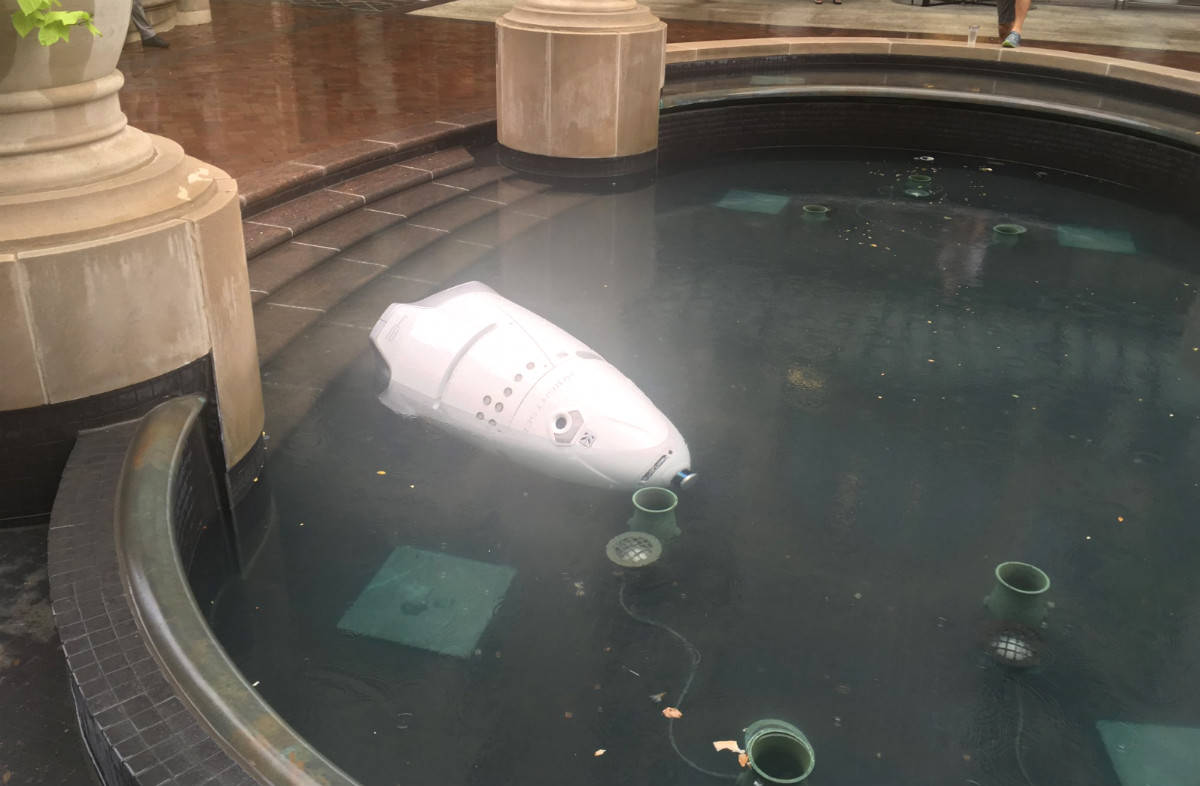
Robohub.org
The Drone Center’s Weekly Roundup: 7/24/17

The K5 security robot fell into a fountain in Washington, D.C.
July 17, 2017 – July 23, 2017
If you would like to receive the Weekly Roundup in your inbox, please subscribe at the bottom of the page.
News
A U.S. drone strike in Afghanistan is reported to have mistakenly killed 15 Afghan soldiers. In a statement, Afghanistan’s Ministry of Defense reported that the strike hit a security outpost in Helmand province. (Voice of America)
The U.K. Department of Transport is developing regulations that would implement a drone registration program, safety courses for drone owners, and more extensive geo-fencing to keep drones out of restricted areas. According to the BBC, it is not yet clear when the new rules will go into effect.
China announced plans to advance the development of artificial intelligence. The State Council of the People’s Republic of China released a plan to grow AI-related industries into a $59.07 billion sector by 2025. (Reuters)
Canada’s transportation safety agency issued an update to its drone regulations. The update relaxes key provisions for recreational and commercial drone users. (CTV News)
Commentary, Analysis, and Art
In testimony before the U.S. Senate, Air Force General Paul Selva argued that autonomous weapons should never be allowed to decide whether or not to take a human life. (Breaking Defense)
In a discussion at the National Governors Association annual meeting, Tesla CEO Elon Musk argued that artificial intelligence is a “fundamental existential risk for human civilization.” (Real Clear Politics)
At Wired, Tom Simonite argues that Musk’s comments are a distraction from the real problems of artificial intelligence.
A report by the Harvard Belfer Center for Science and International Affairs considers how artificial intelligence could revolutionize warfare. (Wired)
At the Wall Street Journal, Jeremy Page and Paul Sonne look at how China is stepping up exports of drones to U.S. allies.
At Scout Warrior, David Hambling looks at how separatists in eastern Ukraine are arming small drones with grenades and other ordnance.
A NASA study found that noise from drones is more irritating to people than noise from cars. (New Scientist)
At Popular Mechanics, Eric Tegler looks at how the U.S. Air Force is testing equipment intended for the Reaper drone on a World War II-era Douglas DC-3.
At War on the Rocks, Gregory C. Allen considers how animals in nature inspire the design of military robots.
Also at War on the Rocks, Scott Cuomo argues that the Marine Corps needs a persistent aerial surveillance and strike drone like the MQ-9 Reaper.
At the Intercept, Robert Trafford and Nick Turse write that Cameroonian forces used a drone base to torture suspected members of Boko Haram.
CNN looks at how Agadez, a city in northern Niger where the U.S. is building a drone base, is an unstable “tinderbox.”
At the Motley Fool, Rich Smith offers suggestions on drone manufacturers to invest in.
Know Your Drone
Researchers at MIT are developing small power-efficient computer chips that could be used to build highly autonomous micro-drones. (The Drive)
An Australian student has developed a drone that is capable of flying for longer and at much higher speeds than other consumer systems. (ABC News)
Airbus Defense and Space conducted a test flight of a subscale model of the Sagitta stealth drone that it is developing with a group of German research institutes. (Aviation Week)
A team at the Singapore University of Technology & Design has developed a vertical take-off drone that transitions to horizontal flight by turning its rotors into wings. (The Verge)
A team at Stanford University is developing a wormlike robot that can move by expanding in size. (Science Robotics)
The Chinese military is developing what appears to be an 8×8 unmanned supply truck. (IHS Jane’s Defence Weekly)
Russian defense firm Kronstadt unveiled the concept for its Orion-E, a military drone that will be about the size of the MQ-1 Predator. (FlightGlobal)
Meanwhile, Russian Helicopters unveiled the VRT3000, a co-axial rotor reconnaissance helicopter drone. (Shephard Media)
Estonian firm Threod Systems is developing a new variant of its Stream tactical military drone. (IHS Jane’s International Defence Review)
Researchers at MIT have developed a small robot that can swim through water pipes searching for leaks. (Dezeen)
YouTube channel Make it Extreme published a video showing how one can build a DIY counter-drone net gun. (Popular Mechanics)
Estonian Startup Marduk Technologies plans to begin testing its Shark counter-drone system with the Estonian military in August or September. (IHS Jane’s International Defence Review)
The U.S. Navy issued a draft Request for Proposals detailing some of the characteristics of its planned MQ-25A Stingray refueling drone. (USNI News)
Israeli firm GPSdome has developed a jam-resistant GPS system for drones. (C4ISRNET)
Ukraine-based defense firm Infocom revealed new details about its Laska armed unmanned ground vehicle. (IHS Jane’s International Defence Review)
Drones at Work
Singapore has offered the Philippines drones and other military equipment for operations against Islamist militant groups. (Reuters)
Police departments in Dorset, Cornwall, and Devon in the U.K. have been using drones to track reckless motorcyclists. (The Drive)
The town of Deadwood in South Dakota has approved an ordinance restricting the use of drones in the city. (Black Hills Pioneer)
Investigators have concluded that a mid-air collision in Australia that was thought to have been caused by a drone was actually caused by a bat. (ABC News)
In a test, the U.S. Navy used its Laser Weapon System to shoot down a drone. (CNN)
A remotely operated robot exploring the interior of Fukushima’s reactor 3 appears to have discovered objects that could be fuel debris. (Japan Times)
The U.S. Air Force has established a program to teach coalition forces how to react to adversary drones on the battlefield. (Unmanned Systems Technology)
A drone flying near the scene of a car crash in Avonport, Canada delayed the departure of a helicopter that was airlifting a patient to hospital. (CBC)
The police department of Harvey County, Kansas found a missing 91-year-old man by using a drone. (KWCH)
Canada’s OEX Recovery group will use a Kraken unmanned undersea vehicle to search for the remains of several subscale prototype jets that crashed into Lake Ontario in the 1950s. (Unmanned Systems Technology)
The U.S. Navy Special Warfare Command is testing a vehicle-mounted SkySafe counter-drone system. (GCN)
LG Electronics has begun a live trial of a series of cleaning and guide robots at Incheon International Airport in South Korea. (ZDNet)
Meanwhile, a Knightscope security robot fell into a fountain while patrolling an office building in Washington, D.C. (CNN)
A drone crashed while racing a Formula E electric race car during an event in Brooklyn. (The Drive)
Industry Intel
Counter-drone company SkySafe raised $11.5 million in a Series A funding round led by Andreessen Horowitz. (TechCrunch)
The U.S. Navy awarded Hydroid a $27.3 million contract modification for the Mk 18 Kingfish family of unmanned undersea vehicles. (DoD)
The U.S. Coast Guard awarded General Dynamics Mission Systems a $29,610 contract for an unmanned underwater vehicle. (FBO)
The U.S. Air Force awarded Engility Corporation a contract for “autonomous collaborative vehicle research and development.” (FBO)
The U.S. Navy awarded Insitu a $39,810 contract for software for the RQ-21A reconnaissance drone. (FBO)
The U.S. Army awarded Leonardo DRS and Moog a $16 million contract to develop a vehicle-mounted counter-drone system. (UPI)
The U.S. Department of Homeland Security awarded General Atomics Aeronautical Systems a $3.9 million contract for UAS operational support and maintenance. (USASpending)
The Defense Advanced Research Projects Agency awarded BAE Systems a $4.6 million contract under the Mobile Offboard Clandestine Communications Approach program. (USNI News)
Georgia’s Innovation Fund Tiny Grant program awarded the Long Cane Middle School an $8,000 grant to develop a curriculum on drones. (The Journal)
U.S. drone firm Measure will offer new inspection services to the solar energy industry. (Unmanned Systems Technology)
Propeller Aero will begin distributing Trimble’s Connected Site, a platform for analysis data from drones. (Unmanned Systems Technology)
Solent Local Enterprise Partnership awarded BAE Systems a $593,871 grant to design a testing site for autonomous systems in the U.K. (Inside Unmanned Systems)
The U.K.’s Ministry of Defense awarded Inzpire Limited a contract to help train pilots of the new General Atomics Protector drone. (Inzpire)
Iran Aircraft Manufacturing Industries announced that it will begin marketing the Hamaseh surveillance and strike drone to international customers. (FlightGlobal)
Israel Aerospace Industries will offer India an agreement to produce the Heron TP domestically. (FlightGlobal)
Israeli drone company Aeronautics will acquire an unnamed U.S. firm for $6 million. (IHS Jane’s Defense Weekly)
For updates, news, and commentary, follow us on Twitter.
tags: c-Aerial, cx-Exploration-Mining, cx-Industrial-Automation, cx-Research-Innovation, drone center's weekly roundup




